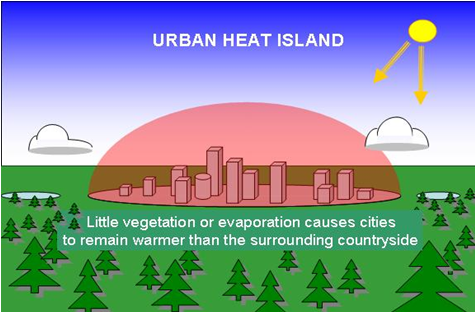Due to the high level of pollutive activities, lack of trees and urbanization, urban areas often exhibit distinct weather conditions different from their surrounding areas such as high temperatures (urban heat island), heavy rains and unusual winds. The most noticeable phenomenon in urban areas is the Urban Heat Island

.
Causes of Urban Heat Islands
High levels of pollution from industrial gases and vehicle emissions results in a more concentrated greenhouse over urban areas. The greenhouse is a layer of gasses in the atmosphere surrounding the earth which traps the outgoing long-wave radiation from earth. Thus as more gases continue to be emitted in urban areas, the greenhouse becomes more enhanced, trapping more heat and intensely warming urban areas.
The lack of trees in urban areas also means more unabsorbed carbon dioxide which contribute to the greenhouse. Concrete surfaces in urban areas have high thermal capacities which means they absorb more heat during the day and releases it at night raising night temperatures. Dark asphalts (roads) have low albedo values therefore store large amounts of heat raising urban temperatures.
Skyscrapers deflect heat and the heat is then trapped again by nearby buildings instead of escaping. Population growth in urban areas means that more carbon dioxide is released by exhalation which traps considerable amounts of heat. In addition, pollutive demands from an increasing population such as cars, and cutting down of trees for construction increases temperatures over urban areas
The use of air conditioners raises temperatures outside as heat is absorbed inside buildings and released outside.
Some Characteristics of Urban Climate
Precipitation & Cloud Cover
In addition to temperature, urban areas often exhibit high rainfalls and more cloud cover than surrounding areas. This is because of more condensation nuclei such as dust and aerosols released by pollutive activities in urban areas.
Also local heatings causes convective uplift of air parcels resulting in copious rains. Rainfall is 30% higher in urban areas than surrounding areas.
Humidity
Humidity in urban areas tend to be low as a result of less vegetation cover and lack of water bodies which contribute to evapotranspiration altogether.
Wind Direction & Speed
Wind in urban areas is greatly affected. Wind speeds are reduced due to friction caused by buildings and skyscrapers. Wind direction is also impacted as it bumps on buildings causing it to be deflected to different areas.
This increases wind turbulence. In addition, wind can be channelled along narrow routes between buildings causing its speed to rise . This is known as the canyon effect. The canyon effect disrupts the free circulation of heat and air.
Air Quality

Air quality in cities is often very poor due to high amounts of pollutive gasses. Of particular concern is Photochemical Smog. This is a mixture of sunlight and gasses that produce a toxic, dangerous chemical that can cause respiratory problems.
Photochemical smog mostly occur in big cities such as Los Angeles, London, Shanghai. The Great Smog in London 1952 caused widespread deaths in the UK.
Mitigating the Urban Heat Effect
Reflective Surfaces
White concrete surfaces have high albedo values thus reflect more heat and help keep urban areas cool
High Albedo Roofs & Green Roofs
Light roof materials helps by reflecting heat. Plants on top of buildings absorb sunlight and carbon dioxide and help to lower temperatures.
Shade Trees
Trees can help to shelter people and buildings from direct sunlight and also absorb and reflect sunlight keeping air cool.
Water Surfaces/ Bodies
Reserving water in certain areas around urban areas helps to lower temperatures as water helps by reflecting heat. In addition, water bodies produce cool breezes that are pleasant and pleasing.
Constructing Porous Surfaces
Porous layers on top of pavements or roads can allow water to infiltrate and cools the surface than dry surfaces. In addition, heat (energy) will be used to evaporate the water rather than storing it on the surface.
Conclusion
The undesirable atmosphere in urban areas has caused some governments to introduce ways of mitigating pollution. In the UK, for instance, tighter controls on tax emission has increased and electrical vehicles are becoming more of an alternative than petrol powered.
However, in LEDCs, such as Zimbabwe, urban climate is becoming more and more undesirable due to high levels of pollution as rapid urbanisation is causing a hyper of activities in urban areas. Read more:Mitigating Air Pollution
